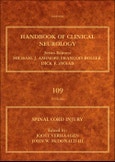Handbook of Clinical Neurology: Spinal Cord Injury summarizes advances in the clinical diagnosis, monitoring, prognostication, treatment, and management of spinal cord injuries. More specifically, it looks at new and important developments in areas such as high-resolution noninvasive neuroimaging, surgery, and electrical stimulation of motor, respiratory, bladder, bowel, and sexual functions. It also reviews the latest insights into spontaneous regeneration and recovery of function following rehabilitation, with emphasis on novel therapeutic strategies, such as gene therapy, transcranial stimulation, brain-machine interfaces, pharmacological approaches, molecular target discovery, and the use of olfactory ensheathing cells, stem cells, and precursor cells.
Organized in five sections, the book begins with an overview of the development, maturation, biomechanics, and anatomy of the spinal cord before proceeding with a discussion of clinical diagnosis and prognosis as well as natural recovery, ambulation, and function following spinal cord injury. It then examines clinical neurophysiology in the prognosis and monitoring of traumatic spinal cord injury; medical, surgical and rehabilitative management of spinal cord trauma; and some new approaches for improving recovery in patients, including restoration of function by electrical stimulation, locomotor training, and the use of robotics. Other chapters cover cell transplantation, artificial scaffolds, experimental pharmacological interventions, and molecular and combinatorial strategies for repairing the injured spinal cord. This volume should be of interest to neuroscience and clinical neurology research specialists and practicing neurologists.
Please Note: This is an On Demand product, delivery may take up to 11 working days after payment has been received.
Table of Contents
SECTION 1 Developmental and Anatomical Perspectives 1. Development and maturation of the spinal cord: implications of molecular and genetic defects; 2. Anatomy and biomechanics of the spinal column and cord
SECTION 2 Diagnosis and Prognosis 3. Clinical diagnosis and prognosis following spinal cord injury; 4. Clinical neurophysiology in the prognosis and monitoring of traumatic spinal cord injury; 5. Concepts of aging with paralysis: implications for recovery and treatment; 6. Advanced MRI strategies for assessing spinal cord injury
SECTION 3 Acute Spinal Cord Injury: Medical, Surgical and Rehabilitative Management 7. Advances in the management of spinal cord and spinal column injuries; 8. Spinal cord injuries in children and adolescents; 9. The changing landscape of spinal cord injury; 10. Surgical treatments to restore function control in spinal cord injury; 11. Advances in the rehabilitation management of acute spinal cord injury; 12. Spasticity; 13. Disordered cardiovascular control after spinal cord injury; 14. New concepts in the prevention of pressure sores; 15. Functional electrical stimulation for bladder, bowel and sexual function; 16. Evidence based therapy for recovery of function after spinal cord injury; 17. Functional electrical stimulation: restoration of respiratory function; 18. Spinal cord stimulation: therapeutic benefits and movement generation after spinal cord Injury; 19. Promoting optimal functioning in spinal cord injury: the role of rehabilitation psychology
SECTION 4 Chronic Spinal Cord Injury The Changing Perspective of Neurorestorative Rehabilitation, Activity-Based and Surgical Restoration Therapies 20. The changing field of rehabilitation: optimizing spontaneous regeneration and functional recovery; 21. The longitudinal spinal cord injury: lessons from intra spinal plexus, cauda equina and medullary conus lesions; 22. Post-traumatic syringomyelia; 23. Post-traumatic deformity: prevention and management
SECTION 5 Preclinical Research Bridging the Gap Between Bench and Bedside 24. Spinal cord injury clinical trials: translational process, review of past and proposed acute trials with reference to recommended trial guidelines; 25. Translating preclinical approaches into human application; 26. Translational spinal cord injury research: preclinical guidelines and challenges; 27. Brain-machine interfaces and transcranial stimulation: future implications for directing functional movement and improving function after spinal injury in humans; 28. Approaches to repairing the damaged spinal cord: overview; 29. Limiting spinal cord injury by pharmacological intervention; 30. Harmful and beneficial effects of inflammation after spinal cord injury: potential therapeutic implications; 31. Defeating inhibition of regeneration by scar and myelin components; 32. Realising the maximum potential of Schwann cells to promote recovery from spinal cord injury; 33. Repair of CNS lesions by transplantation of olfactory ensheathing cells; 34. Cell transplantation: stem cells and precursor cells; 35. Gene therapy, neurotrophic factors and spinal cord regeneration; 36. Scaffolds to promote spinal cord regeneration; 37. Molecular target discovery for neural repair in the functional genomics era; 38. Combination therapies








